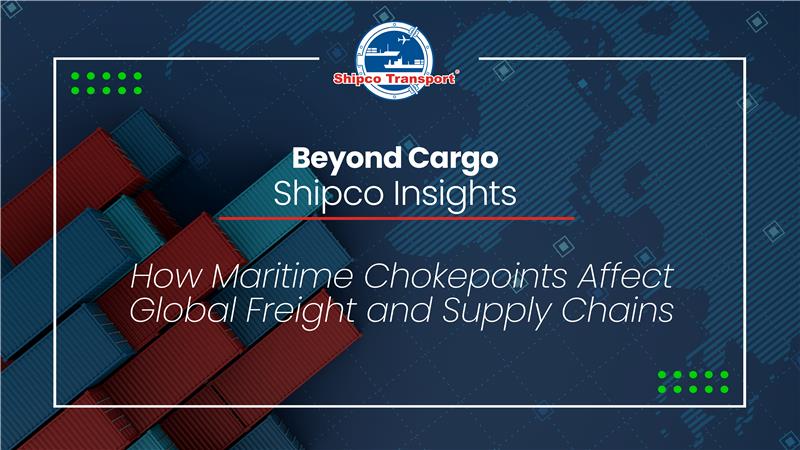No matter how far logistics technology advances, the global freight system still depends on narrow waterways and constrained access points. These maritime chokepoints-some no wider than a few hundred meters (or a few hundred yards) – carry much of the world’s trade. And when traffic slows, everything behind it does too.
For freight forwarders, chokepoints affect transit times, disrupt equipment availability, and complicate planning. Understanding their role is essential to managing exposure and delivering reliable service.
Why these routes matter more than most
 A small number of strategic waterways move a disproportionate share of global trade. The Suez Canal, for example, usually handles roughly 12-15% of global trade and around 30% of container traffic. Despite a traffic drop since late 2023, the passage usually facilitates more than 50 ship transits daily. So, when it’s blocked, those delays compound quickly.
A small number of strategic waterways move a disproportionate share of global trade. The Suez Canal, for example, usually handles roughly 12-15% of global trade and around 30% of container traffic. Despite a traffic drop since late 2023, the passage usually facilitates more than 50 ship transits daily. So, when it’s blocked, those delays compound quickly.
Other chokepoints, like the Strait of Hormuz and the Bab el-Mandeb for example, control the flow of energy and container traffic. In 2023, the Strait of Hormuz alone saw over 20 million barrels per day of oil move through its waters, roughly one-fifth of global oil consumption. Since November 2023, Houthi attacks on commercial shipping have disrupted transits through the Red Sea region, resulting in many carriers diverting around the Cape of Good Hope in South Africa.
The Panama Canal is another critical artery, enabling movement between the Atlantic and Pacific and supporting about 6% of all global maritime trade. However, drought conditions in 2023 and 2024 forced authorities to reduce daily crossings, and while limits have since eased, the episode underscored how environmental shifts can sharply restrict capacity with little warning.
In each case, these narrow corridors carry an outsize share of global volume. When disruption occurs, the alternatives are longer, costlier, and harder to manage.
The supply chain impact of a disrupted chokepoint
A delay at a chokepoint doesn’t stay at a local level. The effects ripple through supply chains for weeks after a blockage clears. For instance, in 2021, the grounding of the Ever Given in the Suez Canal caused a backlog of over 400 ships. Transit times increased by up to 12 days on rerouted services around the Cape of Good Hope, and the value of stranded goods was estimated at nearly $9 billion per day. These disruptions trigger:
- Unpredictable ETAs
- Blank sailings and vessel bunching
- Delayed container repositioning
- Rate volatility due to shifting demand
Knock-on effects often extend well beyond the chokepoint itself. A delayed inbound container can disrupt outbound schedules, delay warehouse operations, or trigger a chain of missed handoffs. Congestion at one port can create equipment shortages at another, making it harder to secure containers where they’re needed. Forwarders are left dealing with the fallout—adjusting plans, managing frustrated customers, and absorbing cost fluctuations they didn’t cause. That means when a chokepoint slows down, freight forwarders absorb the uncertainty first. Their customers don’t ask where the bottleneck occurred but why the delivery was late.
What forwarders need from their partners during disruptions
 No logistics provider can prevent canal closure or geopolitical tension. However, forwarders working with the right partners are better positioned to respond when it happens.
No logistics provider can prevent canal closure or geopolitical tension. However, forwarders working with the right partners are better positioned to respond when it happens.
What matters in these moments:
- Access to multiple carriers and routings to maintain flexibility during disruptions
- Flexible space options to reroute cargo quickly
- Clear, early updates when disruptions affect schedules
- Operational support to adjust consolidation, documentation, or inland planning
- Experience in responding to real-time events without overpromising
Forwarders also need support that does not add complexity. When a chokepoint incident forces a route change, quick coordination between offices, accurate documentation, and aligned expectations become critical. The ability to pre-empt issues before they reach the end customer is what separates a reactive provider from a steady one.
Predictability is built before the crisis happens
It starts with a broad network of strong carrier relationships, ensuring options are available when primary lanes become unreliable. Backed by a disciplined internal framework, Shipco maintains control and consistent performance through more than 90 owned offices in over 30 countries. This structure is further reinforced by long-standing alliance partnerships with likeminded neutral partners who share the commitment to reliability and operation integrity.
Predictability is not something created in response to a crisis. It’s embedded in systems, communication, and structure – well before the crisis begins.

